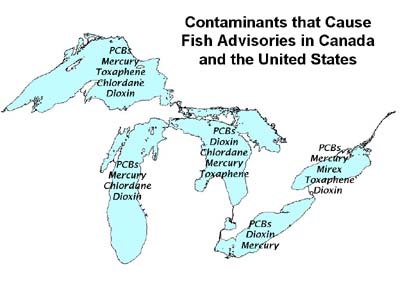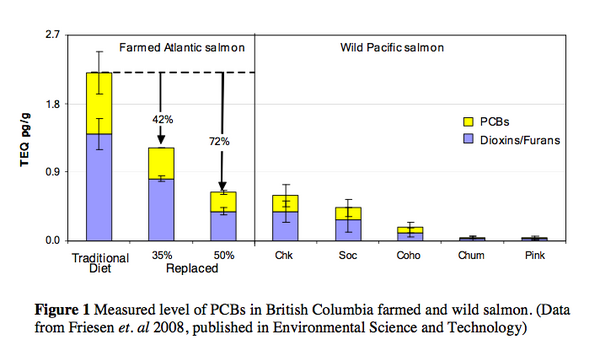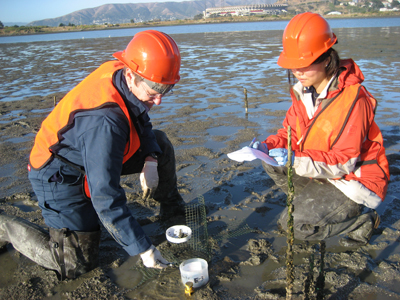
PCBs may impact sports fishing for years to come
Anyone who believes that man cannot negatively impact the environment need look no further than the impact on sports fishing in the Great Lakes Region of the United States.
The Great Lakes represent the 21% of the world’s supply of fresh water, and 84% of North America’s fresh water; only the polar ice caps contain more fresh water. Yet the impact of industrial waste, not just mercury as referred to here, but Polychlorinated biphenyls (PCBs) included the loss of the Great Lakes sports fishing from the 1940’s on. The toxins continue, years after they have been banned, and are responsible for the trout’s inability to re-populate the lakes. Entire generations have grown up on the shores of the Great Lakes without being able to enjoy sports fishing.
The Great Lakes are not alone, most streams, rivers, waterways, and lakes have been contaminated with PCBs.
What Are PCB’s
PCBs belong to a broad family of man-made organic chemicals known as chlorinated hydrocarbons. PCBs were domestically manufactured from 1929 until their manufacture was banned in 1979. Due to their chemical properties, PCBs were used in hundreds of industrial and commercial applications including electrical, heat transfer, and hydraulic equipment; as plasticizers in paints, plastics, and rubber products; in pigments, dyes, and carbonless copy paper; and many industrial applications.
PCBs may still be present in products and materials produced before the 1979 PCB ban. Products that may contain PCBs include:
Transformers and capacitors
Other electrical equipment including voltage regulators, switches, reclosers, bushings, and electromagnets
Oil used in motors and hydraulic systems
Old electrical devices or appliances containing PCB capacitors
Fluorescent light ballasts
Cable insulation
Thermal insulation material including fiberglass, felt, foam, and cork
Adhesives and tapes
Oil-based paint
Caulking
Plastics
Carbonless copy paper
Floor finish

Release and Exposure of PCBs
Prior to the 1979 ban, PCBs entered the environment during their manufacture and use in the United States. Today PCBs are still released into the environment from poorly maintained hazardous waste sites that contain PCBs; illegal or improper dumping of PCB wastes; leaks or releases from electrical transformers containing PCBs; and disposal of PCB-containing consumer products into municipal or other landfills not designed to handle hazardous waste. PCBs are also be released into the atmosphere by the burning of wastes in municipal and industrial incinerators.
Once in the environment, PCBs do not readily break down and therefore may remain for long periods of time cycling between air soil, and ultimately entering the water. PCBs are carried long distances and have been found in snow and seawater thousands of miles from where they were released into the environment. As a consequence, PCBs are found all over the world.
PCBs accumulate in the leaves of plants and food crops, but our concern here is seafood.
Polychlorinated biphenyls (PCBs) production was banned in 1979, but their stable nature prevents breakdown in the environment. There are still products that contain PCB’s and often they are not disposed of properly, entering the environment and most in the rivers, lakes, and oceans. In 2007, 25 years after the banning PCBs, the San Francisco Bay area sports fish had ten times the level of PCB above what is recommended for human consumption. This not only affects the sports fishing industry, but moves up the food chain and will affect those creatures who eat the seafood, in some areas that includes endangered species, and in some areas that includes the unwise fisherman who thinks he is catching something great and tasty for his family.
PCBs, like mercury give no hint that they are present in the seafood. Like mercury, PCBs have no taste, or color, or odor, and are not destroyed by cooking.
Health Affects of PCBs on Humans
The major source of PCB’s in humans is from eating fish caught in contaminated waters. PCBs remain in waters for decades. PCB’s have been demonstrated to cause cancer, as well as affecting the immune, reproductive, nervous, and endocrine system in adults. In infants and children they have been associated with low birth weight, learning disabilities, developmental disabilities, and diminished growth. PCB’s are endocrine disruptors, mimicking thyroid hormones in rats.
PCBs continue to be a threat to humans, as most PCBs enter into the environment and are concentrated up the food chain, much like mercury. PCB’s attach to particulates settling in bottom sediments where bottom-dwelling organisms ingest them and pass them up the food chain. The highest risks of PCBs are in the developing fetus, or a nursing infant.
Farm Raised Fish and PCBs

Levels of PCBs have continued to lower in farm raised salmon since the farmers have worked hard to change the feed formulations
PCB levels have continued to drop in wild stocks, but because of being able to select feed for aquaculture PCB levels have declined even more dramatically in farmed fish. Farmed salmon, trout, arctic char, bass, are essentially PCB free.
Many will site the 2004 Science magazine reported that reported farmed Atlantic salmon from Main and eastern Canada had double and sometimes eight times the levels of PCBs as wild Alaskan Salmon. The PCBs in farm-raised salmon came from the feed, which is made up of the smaller fish that had accumulated PCBs.
Since 2004, salmon farmers altered the diet of farm-raised salmon to ensure PCB levels continued to decline. Levels of PCBs in Atlantic salmon are now less than one percent of the level USDA’s recommendation. The aquaculture salmon farmers were so successful that 2010 Dietary Guidelines for Americans set no consumption limits for farm-raised salmon, not even for pregnant and breast-feeding women.
The U.S. Environmental Protection Agency (EPA) set screening levels for PCB’s in fish tissue at 0.01 ppm, which would translate to one additional cancer in a population of 100,000 for an adult eating one meal a month over their lifetime. The FDA has higher standards for PCBs at 2.0 ppm is to prevent consumers from eating fish in the interstate market, but should not be used as a standard by which sports fishermen, or any human, should consume fish.
The PCB’s tend to build up in the fatty tissues of the fish, and cleaning and cooking fish with potential contamination include: throwing away all internal organs, head, and tail. Removing the dark fat on the fish’s backbone. Removing the belly fat, and avoiding eating raw fish. Skin does not affect levels of PCBs in fish. While such may mitigate those who catch fish in lakes, streams, and rivers – the long-term answer for PCB’s is an expensive clean up of the waterways and better disposal of PCB’s.
One of the more unique methods has come from a Stanford team that is adding activated charcol to the bay and showing that PCBs tend to stick more to charcoal. Clams dug up from the area show one tenth the amount of PCBs as those in areas without the charcoal.

Checking clams for PCB levels in San Francisco Bay
